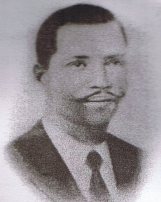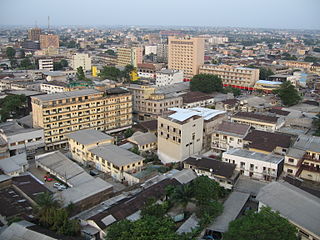
Rudolf Duala Manga Bell was a Duala king and resistance leader in the German colony of Kamerun (Cameroon). After being educated in both Kamerun and Europe, he succeeded his father Manga Ndumbe Bell on 2 September 1908, styling himself after European rulers, and generally supporting the colonial German authorities. He was quite wealthy and educated, although his father left him a substantial debt.

doual'art is a non profit cultural organisation and art centre founded in 1991 in Douala, Cameroon and focussed on new urban practices of African cities.

Douala is the largest city in Cameroon and its economic capital. It is also the capital of Cameroon's Littoral Region. Home to Central Africa's largest port and its major international airport, Douala International Airport (DLA), it is the commercial and economic capital of Cameroon and the entire CEMAC region comprising Gabon, Congo, Chad, Equatorial Guinea, Central African Republic and Cameroon. Consequently, it handles most of the country's major exports, such as oil, cocoa and coffee, timber, metals and fruits. As from 2018, the city and its surrounding area had an estimated population of 2,768,400. The city sits on the estuary of Wouri River and its climate is tropical.

Marilyn Douala Bell is a socio-economist and current president of the cultural organisation doual'art based in Douala, Cameroon.

Goddy Leye was a Cameroonian artist and intellectual.

The Palace of the Kings Bell situated in Douala is a building constructed in 1905 by the Germans for King Auguste Manga Ndumbe. The building is also known as La Pagode; this name comes from the French writer Louis-Ferdinand Céline, who remained in Douala in 1916-17, who calls it such in his famous novel Voyage au bout de la nuit.

The old German government headquarters situated in Douala is a building constructed in 1891 by the Germans in a classical Prussian style.

The former Palace of Justice of Douala situated in Douala is a building originally constructed between 1930-31 under the French Mandate.

The former General Hospital situated in Douala is a building constructed in 1896 by the Germans and designed by the architect Henri Drees.

The Bonakouamouang Chimney – situated in Douala, Cameroon in the district of Akwa neighborhood of Bessegue – is a relict of the waterworks built by the Germans at the beginning of the 19th century. The waterworks was part of the first phase of industrial investments aimed at the urbanisation of Kamerunstadt (Douala).

The former police station situated in Douala is a building constructed at the beginning of the 20th century by the Germans to serve as the first police station under the German mandate.

The Cathedral of Saints Peter and Paul - situated in Douala, Cameroon - is the cathedral of the Roman Catholic Archdiocese of Douala and dedicated to St Peter and St Paul.

The Chamber of Commerce in Douala, Cameroon is a building constructed between 1927 and 1928 under the French mandate, under the umbrella of the League of Nations. This building is in a late Art Nouveau architectural style.
The following is a timeline of the history of the city of Douala, Cameroon.

La Nouvelle Liberté is a public artwork in the Deido suburb, in Douala (Cameroun).

Joseph-Francis Sumégné was born on 30 July 1951 in Bamenjou, Cameroon. Painter and sculptor since 1976, he is a self-taught artist. He lives and works in Yaoundé (Cameroon).

Danièle Diwouta-Kotto, is a Cameroonian designer and architect, member of the Cameroon architects association (ONAC) and founder of the V.A.A. Villes et Architectures d'Afrique organization.
Alexandre Douala Manga Bell was head of the Duala people in Cameroon, German officer and French politician.


















